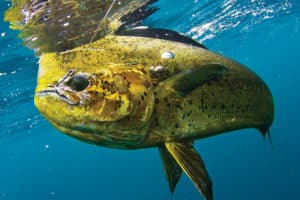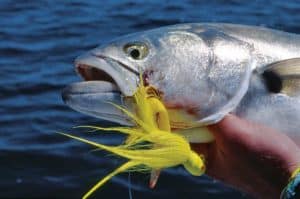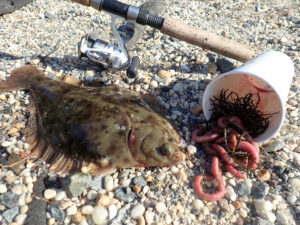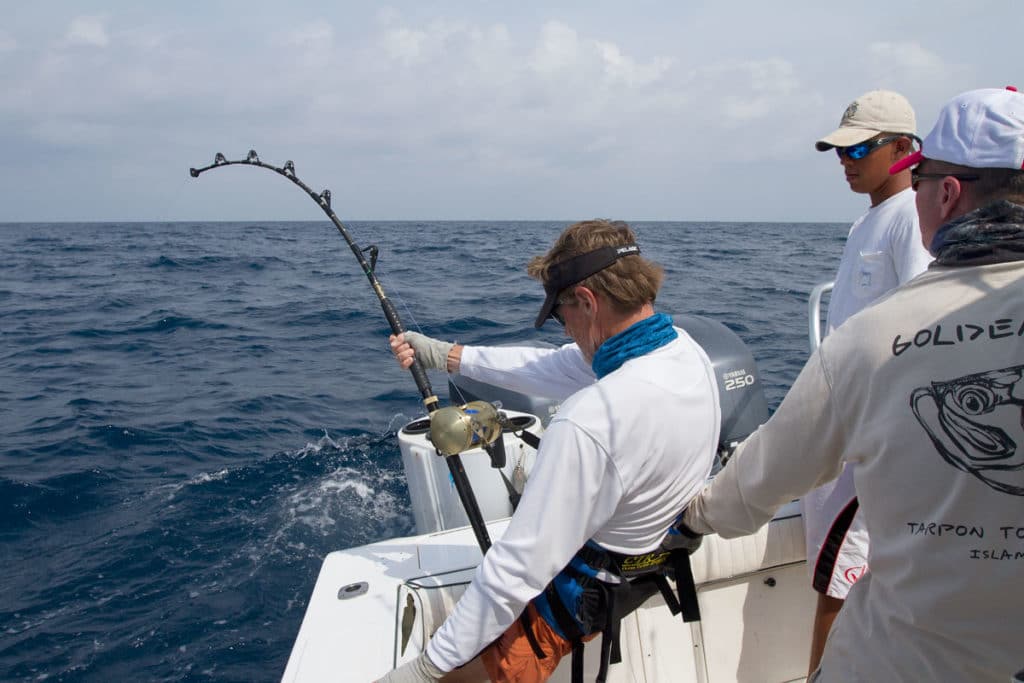
Tackling monster fish from an open boat — such as a center-console or walkaround — ranks as one of the most adrenaline-charged experiences in the angling world, putting you closer to the water and to big sharks, billfish, and tuna than you could ever get on a large sport-fisher.
Open boats (which usually have outboard power) are also more nimble, and many models allow for great angler mobility, especially when using stand-up tackle.
Of course, smaller boats also come with disadvantages. Unless you’re in one of today’s supersize open-fishermen, you can’t deal as well with heavy seas.
Learning what it takes to defeat behemoths from an open boat requires experience, according to Ben Secrest, national sales manager for Accurate Fishing Products. Not all of such experiences are good. “I have spent years learning to effectively fight big fish from relatively small boats,” he says. “You learn from your mistakes, as well as your victories.”
Secrest’s victories are notable in the saltwater-angling community. He has landed big fish around the world. In Puerto Vallarta, Mexico, he has battled massive yellowfin tuna. On his home grounds off Southern California, he has landed thresher sharks as large as 300 pounds and swordfish as heavy as 116 pounds from center-consoles as small as 20 feet in length.
For a jump-start in the learning process, we talked with Secrest and other captains who regularly challenge huge fish from open boats, and created this 10-point battle plan.
1. Maintain Communication
Communication between the captain and the angler (and the deck mate, if you have one) proves critical throughout the fight, which might last hours, according to Secrest. “One of the most important things is the direction of the fishing line,” he says. “The other is to communicate to the captain whether the fish is taking line, holding or you’re gaining line.” All of these factors help the skipper determine how and where to maneuver the boat during the fight.
Teams that fish together often have honed their communication techniques to include hand signals, which become more effective when the angler is facing away from the helm (and the captain can’t hear him) or wind noise makes voice communications difficult. A raised fist, for instance, may signal that the fish is holding, while a rolling finger may indicate a fish is taking line.
2. Know Your Fish Species
You need to know the characteristics of the species you’re targeting, according to Greg Stotesbury, national sales manager for AFTCO, who has fished for marlin, makos, swordfish, threshers and tuna from open boats virtually all of his life. “With striped marlin off Baja and Southern California, for example, we try to keep fish out in front of the boat with the angler in the bow,” explains Stotesbury, who has successfully caught and released stripers as large as 300 pounds. “We don’t press them very hard but try to keep as much line on the reel as possible, as we generally run down on them, keeping the fish at about 11 or 1 o’clock.”
With species such as swordfish and tuna that want to fight deep, it’s a different story. “We keep these fish out behind the boat,” reveals Stotesbury, who has landed bigeye tuna as large 165 pounds and swordfish up to 248 pounds. “You want to make the fish follow you as much as possible.” The idea is to idle the boat ahead of the fish, with the angler in the aft cockpit, applying pressure that keeps the fish coming toward the surface.
3. Learn the Species’ Personality
Beyond knowing the fighting characteristics of the species, try to learn the unique personality of the fish you have hooked, says Stotesbury. “With a marlin, in particular, there’s usually one direction [of line pressure] the fish doesn’t like,” he explains. “It could be from the fish’s right or left side or over the back. Whatever it is, it will provoke a reaction, such as bringing the fish to thrash its bill on the surface.”
Once you know this, you can more easily influence the fish. “If, for example, the fish goes deep, apply some pressure from the angle he doesn’t like, and he may well come to the surface.
4. Don’t Back Down the Boat
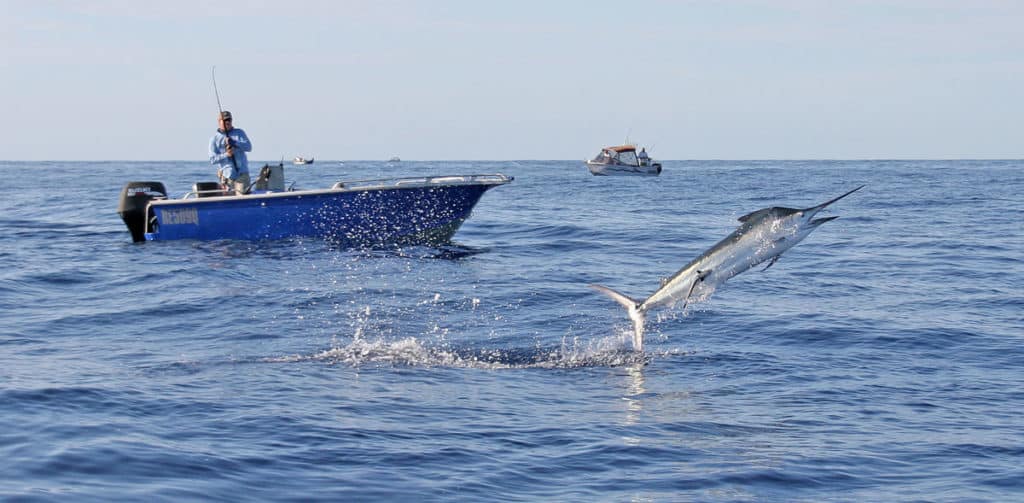
Unlike large sport-fishers, open boats are not well suited for backing down hard on a marlin when you need to gain line. Some can swamp, and even capsize, as waves pour in over the transom and can’t drain back out fast enough while in reverse, even with a self-bailing deck design.
On the other hand, open boats — especially center-consoles — excel when it comes to chasing fish in forward gear, according to Wil Rogers, large-boat business manager for Boston Whaler, who has landed blue marlin as large as 450 pounds in the Bahamas and blacks as large as 750 pounds in Panama from boats such as the Whaler 370 Outrage center-console.
“Place the angler in the bow as the boat motors forward,” he advises. “Keep the line vectored at about 10 or 2 o’clock, depending on which side, motoring at about 2 to 3 knots to gain line.”
If the seas are too rough for the angler to fight from the bow, you can keep him just aft of the console area, and essentially motor forward that same way you would if the angler were in the bow.
5. Avoid a Vertical Fight
Most of the skippers we talked with strongly advised against getting into a vertical fight with fish, no matter what kind of boat you fish from.
“If the fish wants to go straight down, drive away from it, whether it’s a mako shark, marlin, swordfish, thresher or tuna,” says Secrest.
“Don’t get right on top of the fish. Motor about 50 yards away from the fish to change the angle of pressure, and keep that angle,” he adds. Not only does this help move the fish toward the surface to shift the advantage to the angler, it helps prevent the line from getting fouled or cut by the propellers, skegs or trim tabs as the fish circles under the boat in a prolonged vertical fight.
Some fish — mako sharks in particular — can also become erratic, sometimes rocketing to the surface unexpectedly. This is another reason to keep the fish away from the boat, so you can easily take up any slack line by motoring away even farther.
6. Try the Unexpected
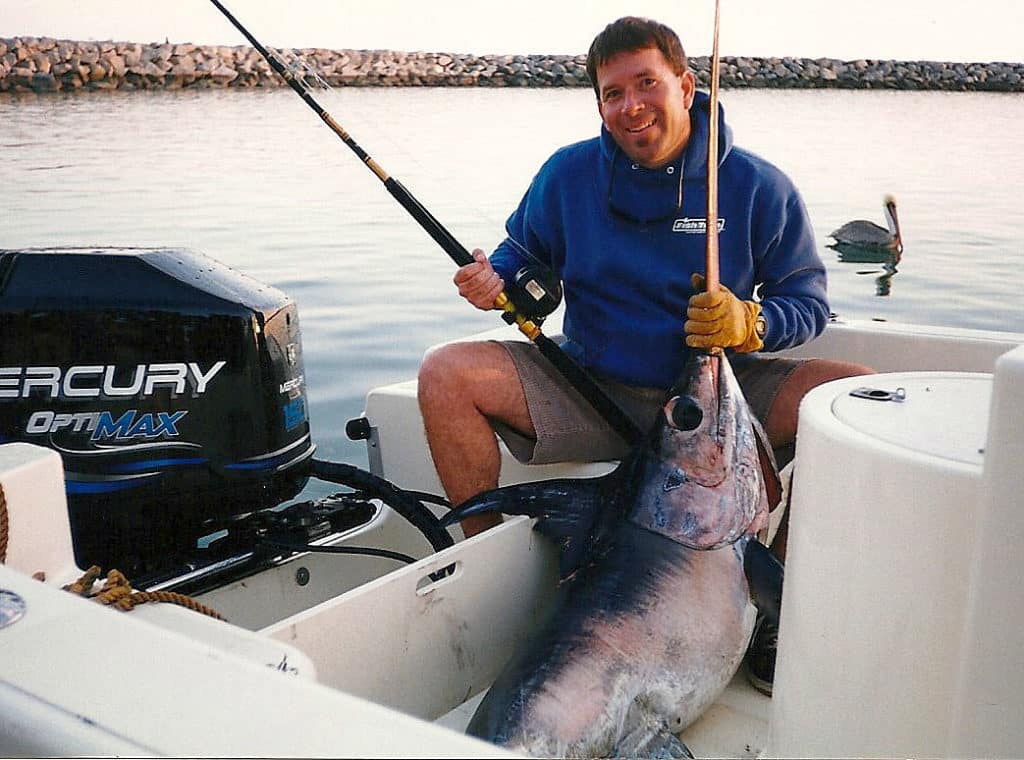
The longer a fight drags on, the greater the chances that a hook will pull, a line will break, a knot will give way, or you will suffer a tackle failure. So you want do whatever you can to shorten the fight, particularly when a fish is dogging it deep and refuses to come up.
“When that happens, try doing something unexpected,” says Secrest. “For example, try quickly changing the angle on the fish.” In this scenario, if you’re pulling from the fish’s right side for 20 minutes with no progress, maneuver to the fish’s left side and apply pressure from a new angle. The maneuverability of an open boat allows you to do this fairly quickly, but it’s also important for the angler to keep the line tight as the captain jockeys the boat around.
Another trick Secrest suggests for a stubborn fish is driving circles around it. “This confuses the fish, and it doesn’t know what direction to pull against, and sometimes it stops pulling all together, allowing you to gain a lot of line in a hurry,” he says.
7. Don’t Stop Moving the Boat
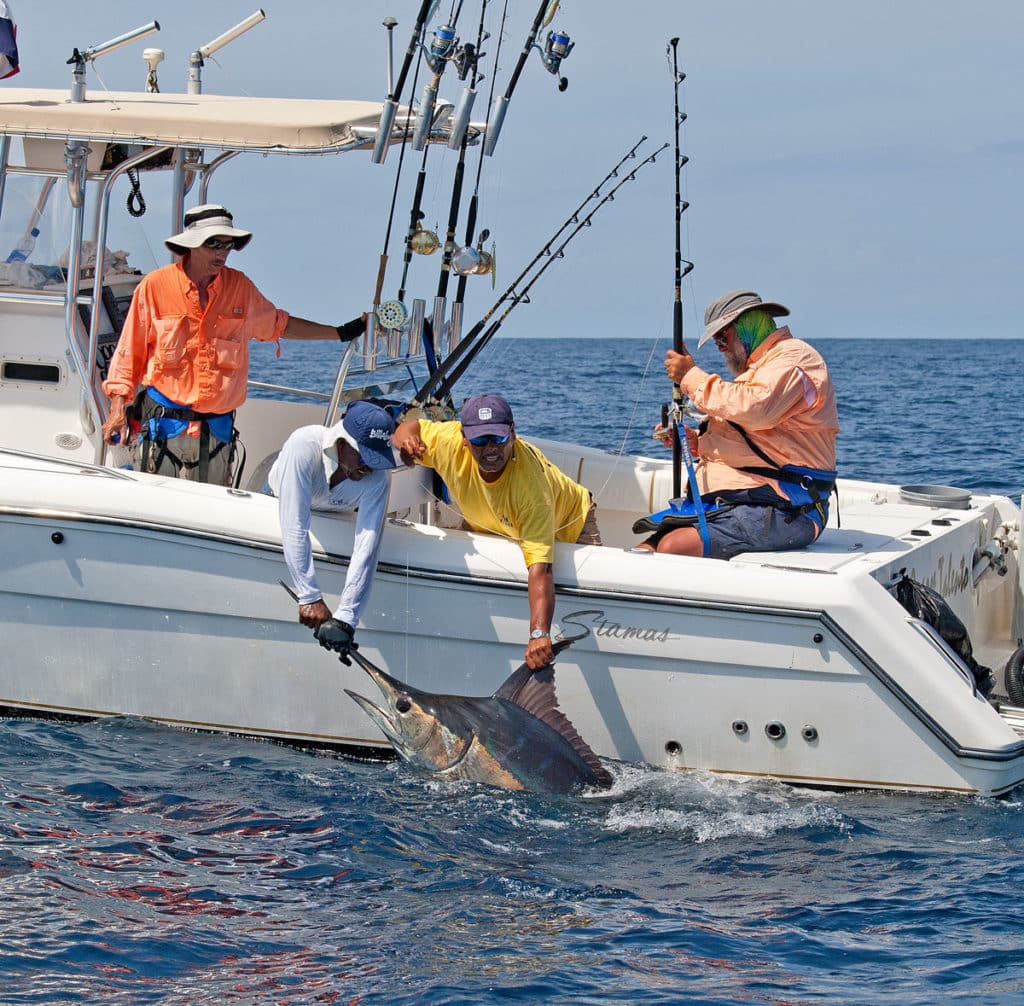
Stopping the boat represents one of the most common mistakes made by rookie captains when fighting big fish. “It is critical that you keep the boat moving,” says Rogers. “This keeps you in control of the fight.”
Staying on the move is important throughout the battle, but particularly so as the fight nears its end, and the fish is close to the boat. “Whether you plan to release or gaff the fish, you want to bring it boat‑side with engines in gear and moving forward,” Rogers advises. You want the fish and boat paralleling each other, so the deckhand can grab the leader. If the fish decides to lunge under the boat or outboards, the deckhand can release the leader as you power ahead to keep the fish at a safe distance.
8. Drive Toward the Line, Not the Fish
In chasing down a fish such as a marlin, always follow the line rather than aim at the fish. “There’s a tendency for the captain to drive toward the fish,” says Stotesbury, “but that can be a mistake because there’s often a big bow of line in the water.”
Even if the fish is jumping abeam or even astern, drive the boat in the direction of the fishing line. This will enable the angler to remain in one position and gain line more quickly as the boat moves forward. As you follow the line and put more of it on the reel, the bow will diminish, and the fish will be more or less in the same direction as the fishing line.
“If you pull the boat out of gear, the fish can go wherever it wants,” warns Rogers, “including under the outboards to cut you off.”
9. Use High-Visibility Fishing Line
To help the captain know where to aim the boat, use high-visibility yellow fishing line for the main line. “I stopped using blue, green or clear line a long time ago,” says Stotesbury. “It was just too difficult to see where the line was going. Now all of my reels for offshore fishing are spooled up with high-viz yellow.”
10. Square Up with the Fishing Line
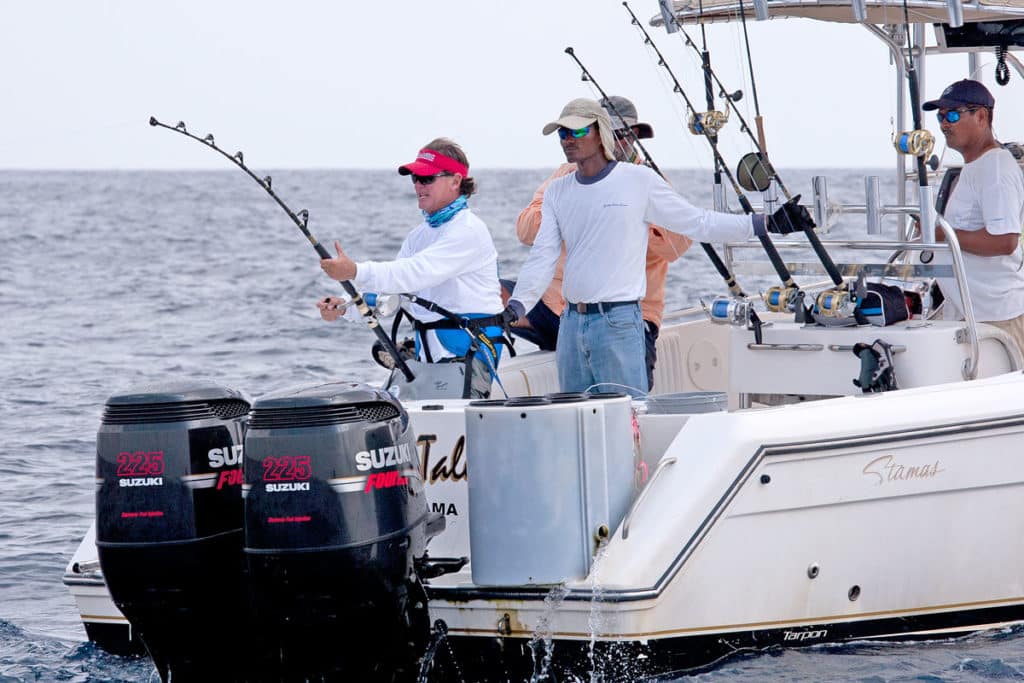
This applies mainly to the angler, especially when the fish is close to the boat and the fight is nearing an end. “Too many anglers get tired and stop moving after a long battle, yet this is the most important time to stay in front of the fish,” says Rogers.
Sometimes the fish makes a fast, last-ditch move — across the bow or stern, for example — and it’s critical that the angler keeps moving to follow the fish, rather than let the leader drastically change its angle and possibly scrape across the fish’s sharp teeth or raspy bill. A sudden change in line angle can also trigger a big jump or violent headshake. On a short line, any of these events are more likely to dislodge the hook or break the already fatigued line.
As indicated earlier, the beauty of an open boat is that the angler can more easily follow the fish to keep the line pointed straight at the marlin, shark or tuna, without relying on or waiting for the captain to maneuver the boat when a fish makes a sudden move.
Fighting a big fish from an open boat will always rate among the most memorable events in an angling career. These tips will help ensure that the memory becomes a good one.
Fighting Around Outboards
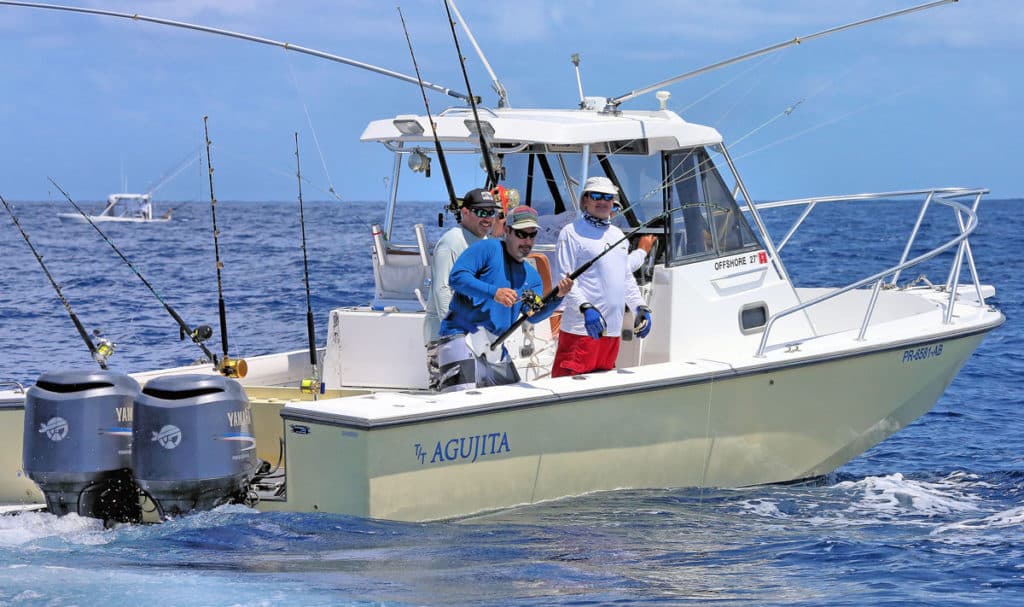
Most of today’s open boats come equipped with outboard engines on extended swim platforms or brackets with full-transom bulkheads. While these designs offer performance and safety benefits, they also create obstacles when it comes to fighting a big fish if it decides to cross under the stern. One touch of the line or leader on a skeg, prop blade or trim tab, and — snip! — adios, monster fish!
The key to avoiding a slice-off is to keep the fish at a distance during the main part of the battle. With marlin, try to keep the fish off the bow. Makos, swordfish, threshers and tuna are best fought from the stern, with the boat angled away from the fish. Avoid a vertical fight in which the fish might be able to swim under the outboard running gear.
As the battle nears an end, control the fish by keeping the boat moving slowly, with the fish paralleling your course. If it tries to lunge under the boat, accelerate to create some distance, and turn into the fish. This, in effect, moves the outboards away from the line.
At the same time, the angler needs to remain nimble, always following the fish and keeping his shoulders perpendicular to the direction of the line as the captain maneuvers the boat.
Multiple Hookups
Hooking two big marlin or tuna at once ranks as a problem for which every angler wishes. But seriously, how do you deal with a pair of monsters that want to run in different directions?
Like a good bird shooter, you have to focus on one target at a time, according to the experts we interviewed. “Pick one fish and concentrate on it first,” says Wil Rogers, of Boston Whaler. “Assume you might lose the other one.”
If the other fish is still on the line by the time you land the first, that’s a bonus. Use the tips we outline in this story to try to land it too.

